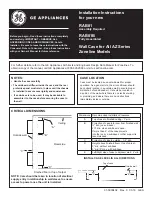
RT-SVX34R-EN
133
directions, LED is open. If low in both directions,
LED is shorted.
•
M
Me
etth
ho
od
d 3
3:: Testing the LED with an analog
Ohmmeter. Connect Ohmmeter across LED in one
direction, then reverse the leads for the opposite
direction. The LED should have at least 100 times
more resistance in reverse direction, as compared
with the forward direction. If high resistance in both
directions, LED is open. If low in both directions,
LED is shorted.
N
No
otte
e:: Measurements should be made from LED
common (ZSM terminal 6 to respective LED
terminal). Refer to the Zone Sensor Module
(ZSM) Terminal Identification table at the
beginning of this section.
Programmable & Digital Zone Sensor Test
Testing serial communication voltage
1. Verify 24 VAC is present between terminals RTRM
J6-14 and RTRM J6-11.
2. Disconnect wires from RTRM J6-11 and RTRM J6-
12. Measure the voltage between RTRM J6-11 and
RTRM J6-12; it should be approximately 32 Vdc.
3. Reconnect wires to terminals RTRM J6-11 and
RTRM J6-12. Measure voltage again between RTRM
J6-11 and RTRM J6-12, voltage should flash high
and low every 0.5 seconds. The voltage on the low
end will measure about 19 Vdc, while the voltage
on the high end will measure from approximately
24 to 38 Vdc.
4. Verify all modes of operation, by running the unit
through all of the steps in
5. After verifying proper unit operation, exit the test
mode. Turn the fan on continuously at the ZSM, by
pressing the button with the fan symbol. If the fan
comes on and runs continuously, the ZSM is good.
If you are not able to turn the fan on, the ZSM is
defective.
ReliaTel Refrigeration Module (RTRM)
Default Chart - CV and SZ VAV Units
If the RTRM loses input from the building management
system, the RTRM will control in the default mode after
approximately 15 minutes. If the RTRM loses the
Heating and Cooling Setpoint input from the
potentiometers, the RTRM will control in the default
mode instantaneously. The temperature sensing
thermistor in the Zone Sensor Module for CV
applications is the only component required for the
“Default Mode” to operate.
Table 76.
Constant volume and single zone VAV
default operations
Component or
Function
Default Operation
Cooling Setpoint
(CSP)
74°F
Heating Setpoint
(HSP) Economizer
71°F Normal Operation
Economizer
Minimum Position
Normal Operation
Mode
Normal operation, or auto if ZSM mode
switch has failed
Fan
Normal operation, or continuous if fan
mode switch on ZSM has failed
Night Setback Mode
Disabled - Used with Integrated
Comfort™ System and Programmable
ZSM’s only
Supply Air
Tempering
Disabled - Used with Integrated
Comfort™ Systems only
DA Cool Setpoint
50ºF (SZ VAV Only)
DA Heat Setpoint
100ºF (SZ VAV Only)
Default Chart - VAV Units
If the RTRM loses input from the building management
system, the RTRM will control in the default mode after
approximately 15 minutes. For VAV units, a “shorted”
mode input is the only input required for the “Default
Mode” to operate. If the RTRM loses setpoint inputs
from the RTAM due to remote setpoint input failure,
the RTRM will use default setpoint inputs as defined in
the default chart for VAV units.
Table 77.
Variable air volume default operation
Component or Function
Default Operation
Supply Air Cooling Setpoint Failure
55° F
Supply Air Reset Setpoint Failure
Disable Reset
Supply Air Reset Amount
Disable Reset
Supply Air Static
Setpoint Failure
0.5 IWC
Supply Air Static
Deadband Failure
0.5 IWC
Morning Warm-Up
Setpoint Failure
Disable MWU and DWU
Mode Failure “Open
“Unit Mode “Off”
Mode Failure “Shorted
“Unit Mode “Auto”
Summary of Contents for Voyager Commercial
Page 153: ...RT SVX34R EN 153 N No ot te es s...
Page 154: ...154 RT SVX34R EN N No ot te es s...
Page 155: ...RT SVX34R EN 155 N No ot te es s...
















































